October 1 - 31, 2025: Issue 647
Ghostly shot of rare hyena in abandoned mining town wins Wildlife Photographer of the Year 2025
October 14,2025
South African wildlife photographer Wim van den Heever has been announced as Wildlife Photographer of the Year 2025 for his powerful image, ‘Ghost Town Visitor’. The competition’s Young Wildlife Photographer of the Year 2025 was announced as Andrea Dominizi, aged 17.
Selected from a record-breaking 60,636 entries from 113 countries and territories, the category and overall winners of the world’s leading wildlife photography competition, Wildlife Photographer of the Year, run by the Natural History Museum, London, were revealed at an awards ceremony this evening.
Among the winners are Western Australian photographer Georgina Steytler in the Behaviour: Invertebrates category for her ''Mad Hatterpillar'' image.
The Natural History Museum stated Georgina Steytler (Australia) showcases the strange headgear of a gum-leaf skeletoniser caterpillar. Georgina had been looking out for this caterpillar for years. When she noticed eucalyptus trees with skeletonised leaves, this was a sign that the animal had been grazing.
She took this image backlit by the setting sun. A fill-in flash illuminated the living head at the base of the stack.
This caterpillar’s unusual headgear is made up of old head capsules, which it keeps every time it sheds its skin. The resulting tower is believed to help deflect attacks by predators.
Georgina is a nature photographer with a passion for birds, conservation and ethics. As well as judging several nature photography competitions, she also conducts workshops and talks across Australia on ethical nature photography. She takes images for, and helps to manage, Australian conservation-based projects. She currently has two books published by Australian Geographic titled For the Love of Birds and For the Love of Flora, which celebrate the unique and beautiful birds and plants of Australia. More at: https://www.georginasteytler.com.au/
Georgina has been a winner in 2018 this category before for her 'Mud-Rolling Mud-Dauber' photo while her 2024 entrant, 'Centre of Attention' of a male Dawson’s burrowing bees vying for access to a female, was Highly Commended.
Georgina Steytler's 'Make and Mend', of a Male satin bowerbird. was also 'Highly Commended' in 2025 in the category for Behaviour: Birds - Portraying memorable, unusual or dramatic behaviour.
To get this picture she used a long lens to record this bowerbird with lilac-blue eyes placing a twig back into its bower. Georgina had been visiting this site for a few days, watching the birds through bushes from a distance.
She took this image soon after the bower had been torn down, its decorations pillaged by a rival, as the bird began rebuilding.
Male satin bowerbirds build structures of interwoven twigs, called bowers. To lure prospective mates, they decorate the bowers with collected objects. Alongside natural materials, these displays often feature bottle tops, drinking straws and clothes pegs.
The overall winner in the Behaviour: Birds catgeory was 'Synchronised Fishing' by Qingrong Yang, China and shows a ladyfish snatching its prey from right under a little egret’s beak
The Behaviour: Invertebrates category is for:
Revealing the most interesting or memorable behaviour of any of the multitude of smaller animals without backbones – whether on land, in the air, or in water.
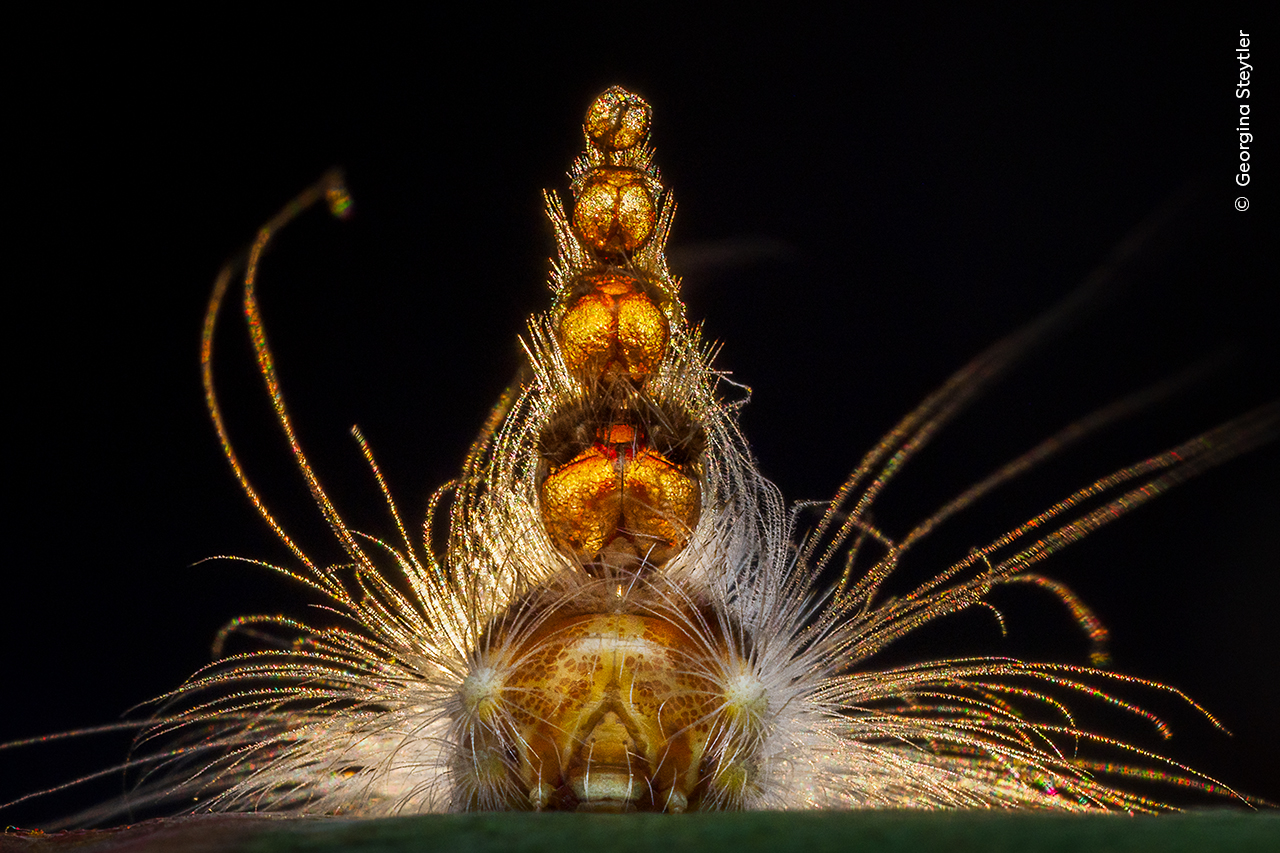
Behaviour: Invertebrates – Georgina Steytler (Australia) (Supplied: Wildlife Photographer of the Year/Wim van den Heever, and courtesy Wildlife Photographer of the Year
Wildlife Photographer of the Year 2025
South African wildlife photographer Wim van den Heever has been announced as Wildlife Photographer of the Year 2025 for his powerful image, ‘Ghost Town Visitor’.
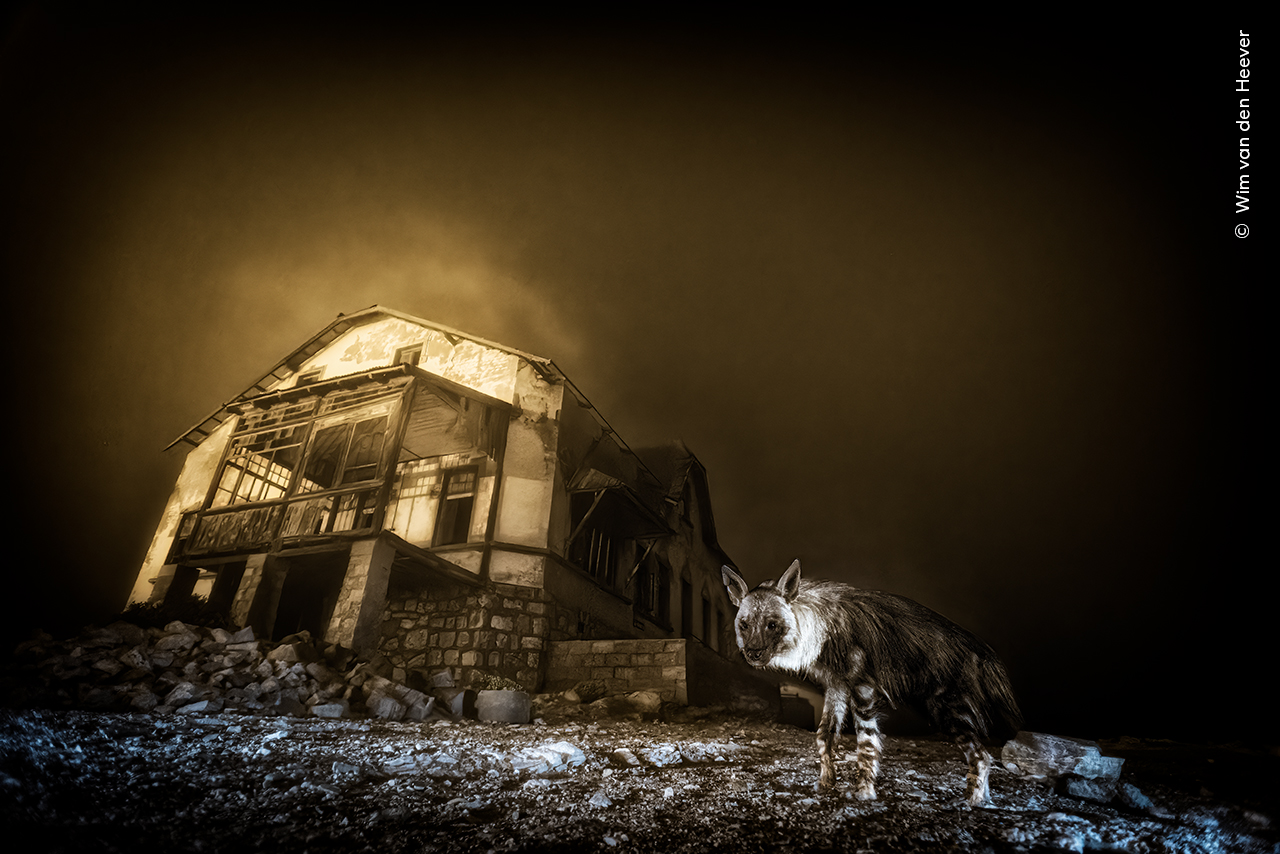
Wim van den Heever won the overall prize as well as the Urban Wildlife category with his photo called Ghost Town Visitor. (Supplied: Wildlife Photographer of the Year/Wim van den Heever, and courtesy Wildlife Photographer of the Year
Highlighting how nature interacts with urban spaces in often unusual ways, Wim's photograph is a haunting yet mesmerising view of a brown hyena visiting the skeletal remains of a long-abandoned diamond mining town in Kolmanskop, Namibia. Testament to the photographer’s determination and patience, using camera trap technology, it took Wim a decade to get this single shot of a brown hyena after first noticing their tracks at the site.
The rarest hyena species in the world, brown hyenas are nocturnal and mostly solitary. They are known to pass through Kolmanskop on their way to hunt Cape fur seal pups or scavenge for carrion washed ashore along the Namib Desert coast. Brown hyenas are rarely seen, so camera trap technology is an effective way for scientists to monitor behaviour and better understand the species.
Kathy Moran, Chair of the Wildlife Photographer of the Year Jury, says: “How fitting that this photograph was made in a ghost town. You get a prickly feeling just looking at this image and you know that you’re in this hyena’s realm. I also love the twist on this interpretation of ‘urban’ – it was once but is no longer a human-dominated environment. Abandoned by miners, wildlife has taken over. Repopulated, if you will. Is it still a town – it would seem that way to me – just no longer ours.”
Akanksha Sood Singh, Jury Member for the sixty-first Wildlife Photographer of the Year competition, says: “This image is an eerie juxtaposition of the wild reclaiming human civilisation. The image is haunting yet mesmerising because the solitary hyena takes centre stage as a symbol of resilience amid the decay. This picture is a multi-layered story of loss, resilience and the natural world’s silent triumph, making it an unforgettable piece of wildlife and conservation photography.”
Young Wildlife Photographer of the Year 2025
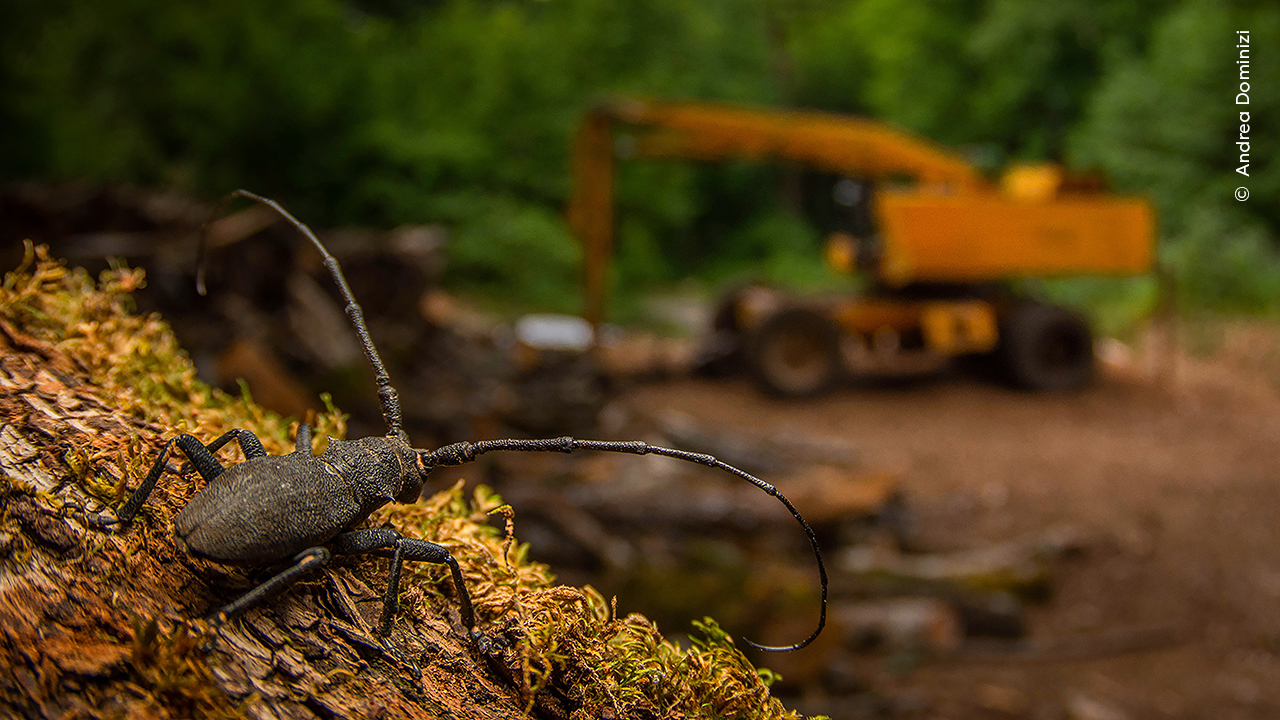
After the Destruction by Andrea Dominizi, Italy. A longhorn beetle near abandoned machinery in the Lepini Mountains of central Italy. (Supplied: Wildlife Photographer of the Year/Andrea Dominizi)
The competition’s Young Wildlife Photographer of the Year 2025 was announced as Andrea Dominizi, the first ever Italian to land the prestigious award for wildlife photographers aged 17.
Andrea won for his image ‘After the Destruction’ which tells a poignant tale of habitat loss. Framed against abandoned machinery, the image spotlights a longhorn beetle in the Lepini Mountains of central Italy, an area once logged for old beech trees.
As longhorn beetles tunnel into dead wood, fungi make their way inside, helping to break it down and recycle nutrients. If the beetles’ habitat is disturbed or destroyed, the effects ripple across the entire ecosystem.
Andy Parkinson, Jury Member for the sixty-first Wildlife Photographer of the Year competition, says: “An image filled with as much narrative and importance as it is with detail. A compelling, but harrowing photograph, it’s one that encourages the viewer to contemplate the nature of this fraught relationship. This image, so beautifully and compositionally crafted will, I hope, stimulate conversation, discussion and an acceptance that we must deviate from our current path because it’s not just our own futures that we’re jeopardising.”
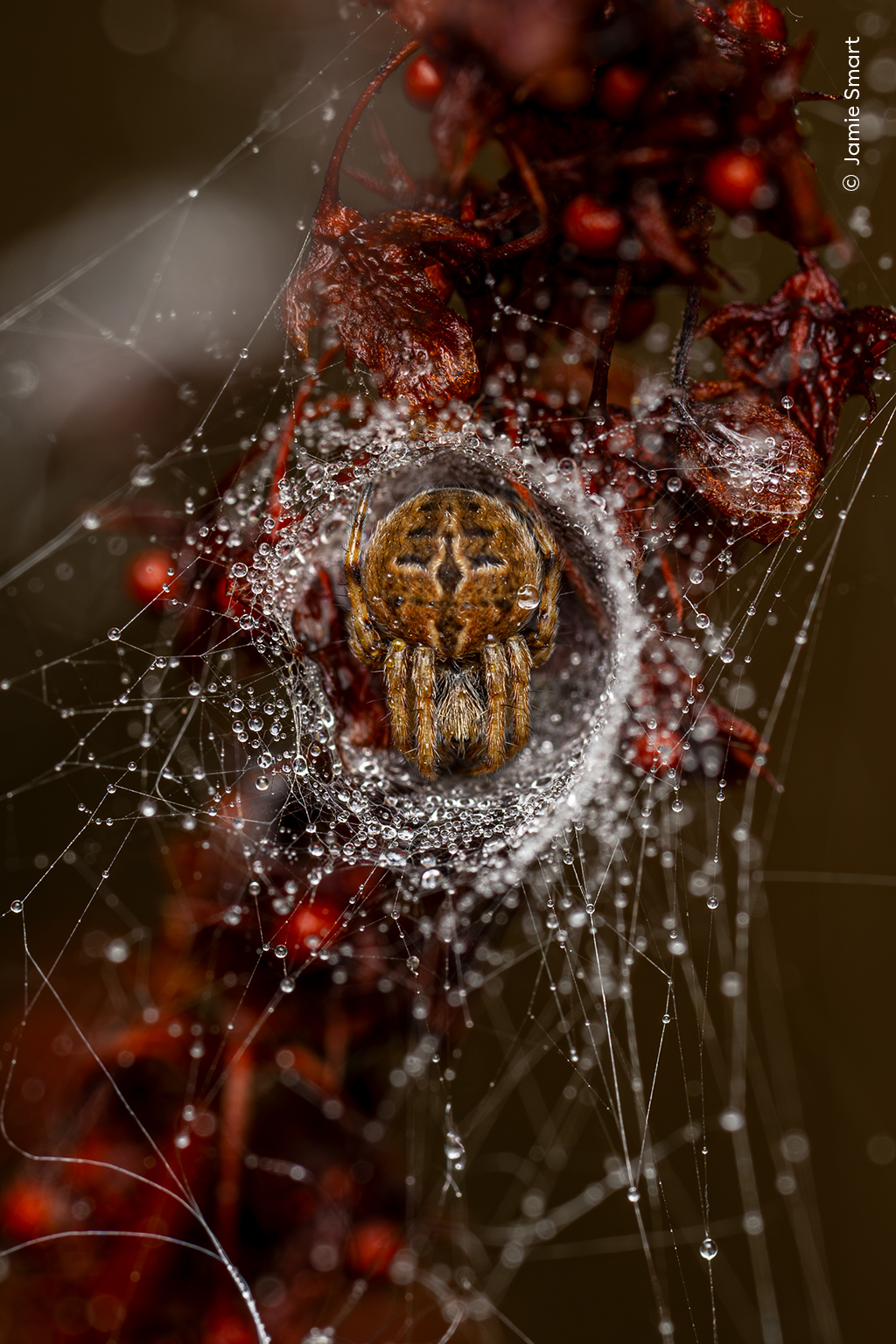
10 Years and Under Winner: The Weaver's Lair by Jamie Smart, UK. An orb weaver spider inside its silken retreat on a cold September morning. (Supplied: Wildlife Photographer of the Year/Jamie Smart)
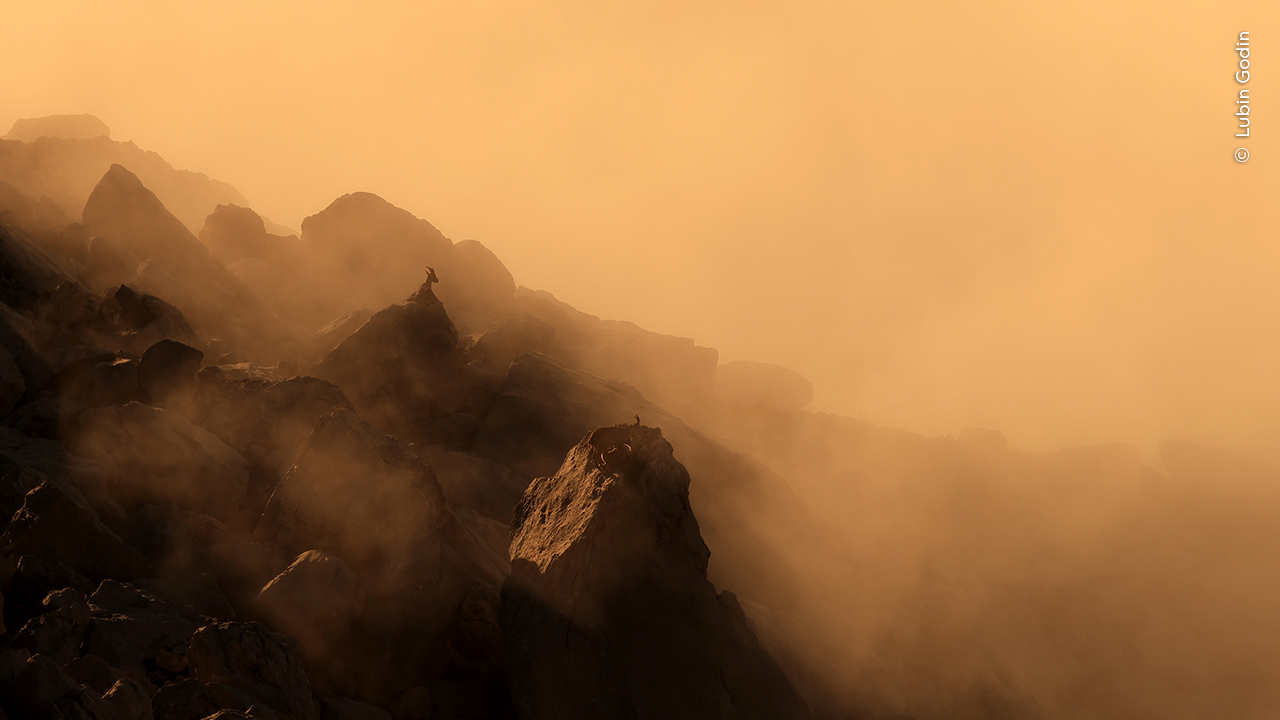
11 to 14 Years Winner: Alpine Dawn by Lubin Godin, France. An alpine ibex rests above a sea of clouds. (Supplied: Wildlife Photographer of the Year/Lubin Godin)
Impact Award 2025
Now in its second year, the competition’s Impact Award recognises a conservation success, a story of hope or positive change. This year, the award was given to Brazilian photographer, Fernando Faciole, for his image ‘Orphan of the Road’.
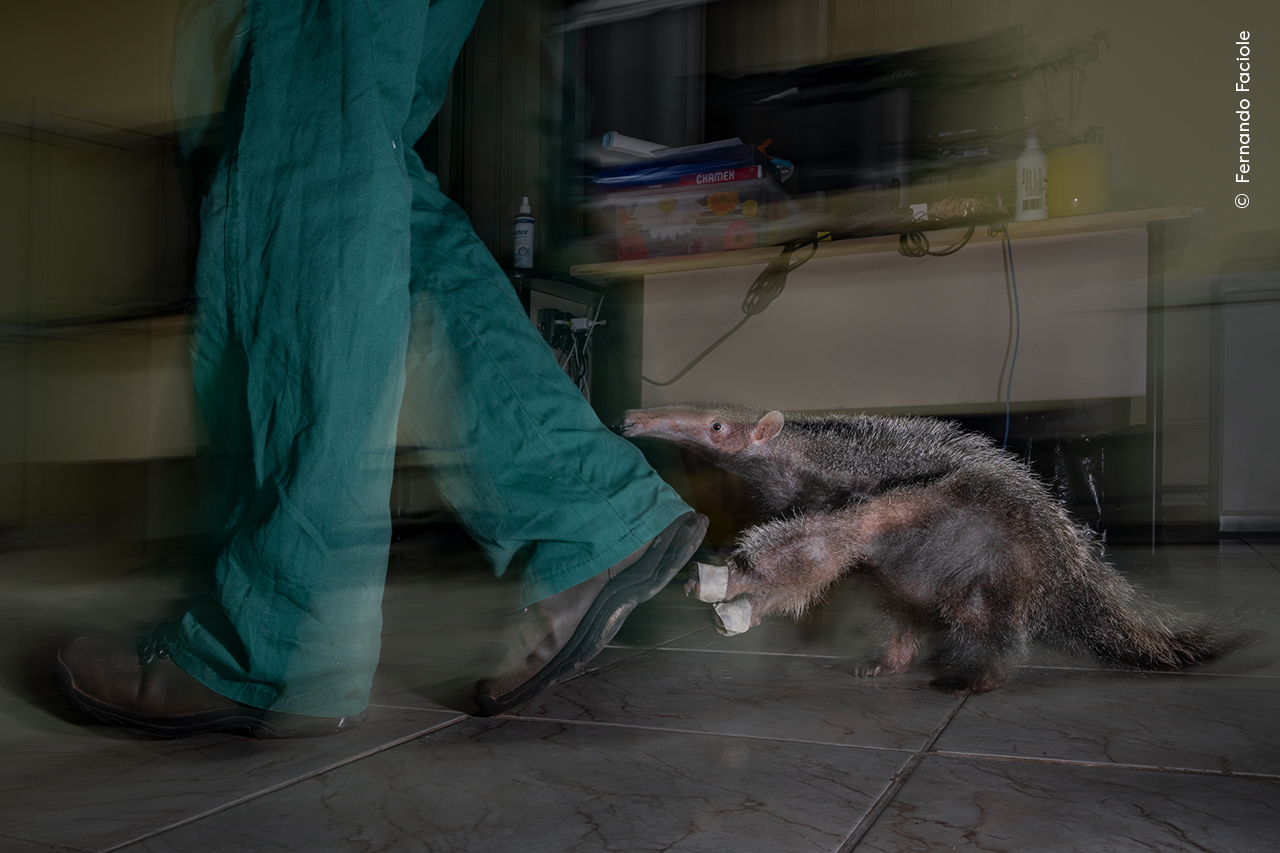
Orphan of the Road by Fernando Faciole, Brazil. An orphaned giant anteater pup follows its carer after an evening feed. (Supplied: Wildlife Photographer of the Year/Fernando Faciole)
Spotlighting an orphaned giant anteater pup following its caregiver after an evening feed at a rehabilitation centre, Fernando’s photograph highlights the consequences of road collisions, a leading cause of the decline in giant anteater numbers in Brazil. The pup’s mother was killed by a vehicle, and the hope is that it will be released back into the wild after being encouraged to develop crucial survival skills by its caregiver.
Alongside rehabilitation centres, the Anteaters and Highways project of the Wild Animal Conservation Institute is developing strategies to reduce anteater deaths on Brazil’s roads. These include erecting fences and building underground tunnels to allow the anteaters to cross safely.
Hans Cosmas Ngoteya, Jury Member for the sixty-first Wildlife Photographer of the Year competition, says: “The anteater depicted in this image symbolises many endangered animals that require our assistance. These animals, without the ability to express themselves verbally, rely on us to ensure their protection and care. This image conveys that message effectively.”
Category Winners and the 61st Wildlife Photographer of the Year Exhibition
The winning photographs will be showcased in an exhibition at the Natural History Museum, London, from Friday 17 October 2025, including 19 category winners across topics ranging from underwater to urban wildlife, and photojournalism to mammal behaviour.
The exhibition will also help visitors understand how our planet’s habitats are changing. Alongside the award-winning photographs, the sixty-first exhibition will provide insight into some of the habitats pictured by including the Natural History Museum’s groundbreaking metric, the Biodiversity Intactness Index (BII). BII measures how much of a region’s natural biodiversity remains on a scale of 0 to 100%. Adopted as an official Global Biodiversity Framework indicator for decision-making, it is an essential tool for understanding, monitoring and communicating biodiversity changes on a global scale and tracking international progress towards conservation goals.
Dr Doug Gurr, Director of the Natural History Museum, says: “Now in its sixty-first year, we are thrilled to continue Wildlife Photographer of the Year as a powerful platform for visual storytelling, showing the diversity, beauty and complexity of the natural world and humanity's relationship to it. With the inclusion of our Biodiversity Intactness Index, this year’s exhibition will be our best combination of great artistry and groundbreaking science yet, helping visitors to become inspired to be advocates for our planet.”
The category winners, as well as the full 100 images selected for the competition’s sixty-first portfolio, were selected anonymously by an international panel of experts across the disciplines of wildlife photography, filmmaking, conservation and science. The images were selected for their originality, technical excellence, and creativity.
The 19 category winners across young and adult categories are:
- 10 Years and Under: Jamie Smart (UK)
- 11 – 14 Years: Lubin Godin (France)
- 15 – 17 Years: Andrea Dominizi (Italy)
- Animals in their Environment: Shane Gross (Canada)
- Animal Portraits: Philipp Egger (Italy)
- Behaviour: Birds – Qingrong Yang (China)
- Behaviour: Mammals – Dennis Stogsdill (USA)
- Behaviour: Amphibians and Reptiles – Quentin Martinez (France)
- Behaviour: Invertebrates – Georgina Steytler (Australia)
- Oceans: The Bigger Picture – Audun Rickardsen (Norway)
- Plants and Fungi – Chien Lee (Malaysia)
- Natural Artistry – Simone Baumeister (Germany)
- Underwater – Ralph Pace (USA)
- Urban Wildlife – Wim van den Heever (South Africa)
- Wetlands: The Bigger Picture – Sebastian Frölich (Germany)
- Photojournalism – Jon A Juárez (Spain)
- Photojournalist Story Award – Javier Aznar González de Rueda (Spain)
- Rising Star Award – Luca Lorenz (Germany)
- Portfolio Award – Alexey Kharitonov (Israel/ Russia)
The sixty-first Wildlife Photographer of the Year exhibition at the Natural History Museum, London, will open on Friday 17 October 2025 until Sunday 12 July 2026. The exhibition will also embark on a UK and international tour to inspire millions to appreciate and conserve the natural world.
The Wildlife Photographer of the Year comes to the Australian Maritime Museum in Sydney annually, with the exhibition running from May to October, well worth a visit next year to see these great shots up close.
You can see all the Wildlife Photographer of the Year photographs online HERE, although please be aware some photographs are of animals hunting etc., and that may cause distress to view them.